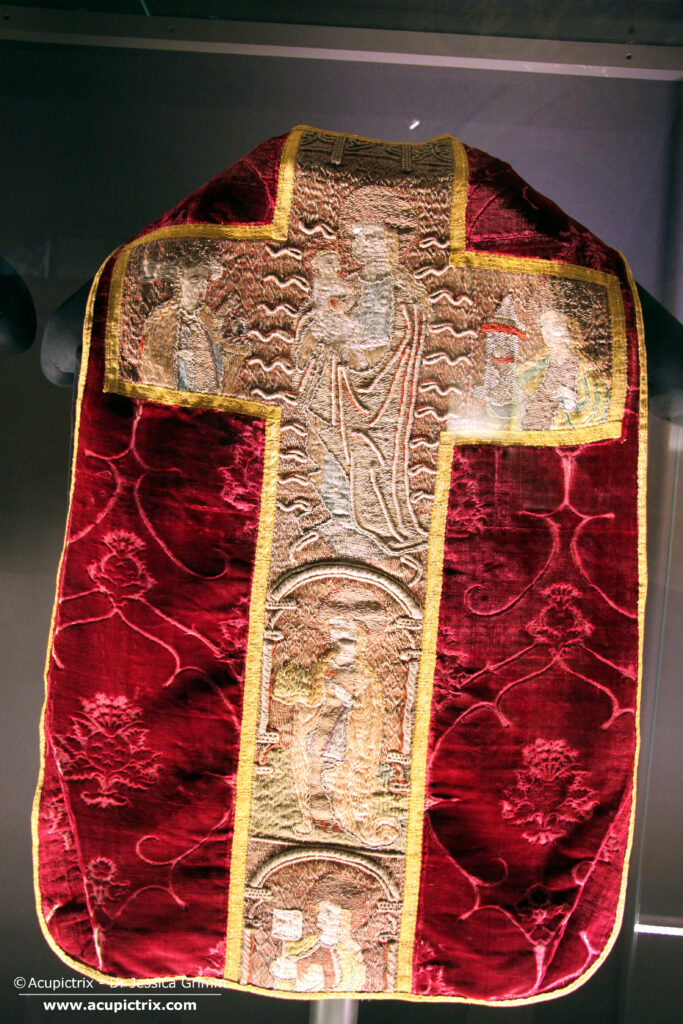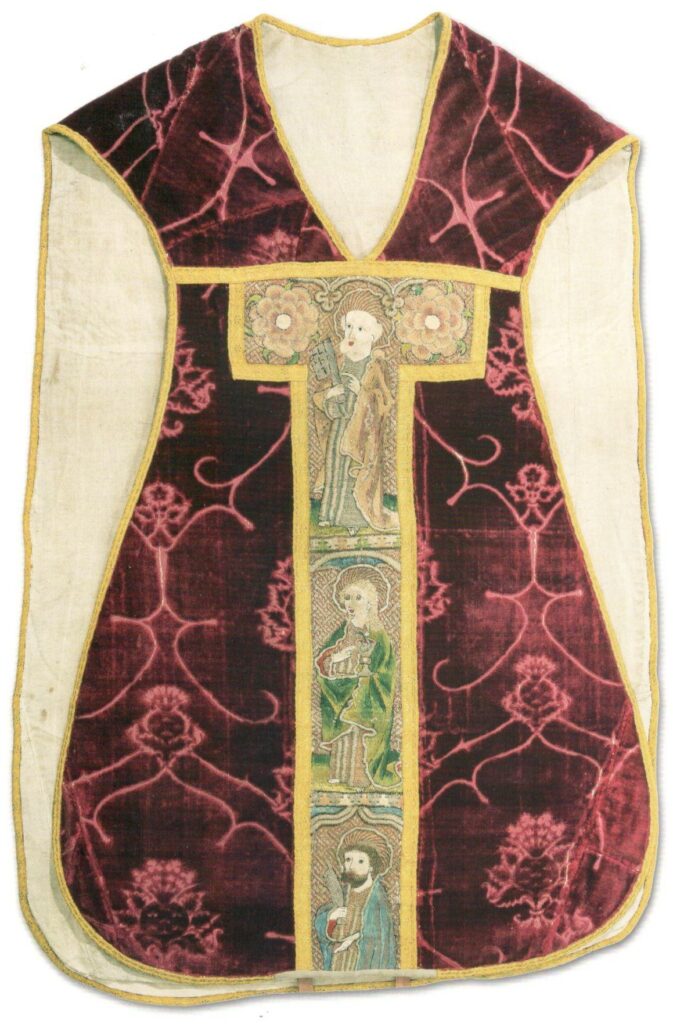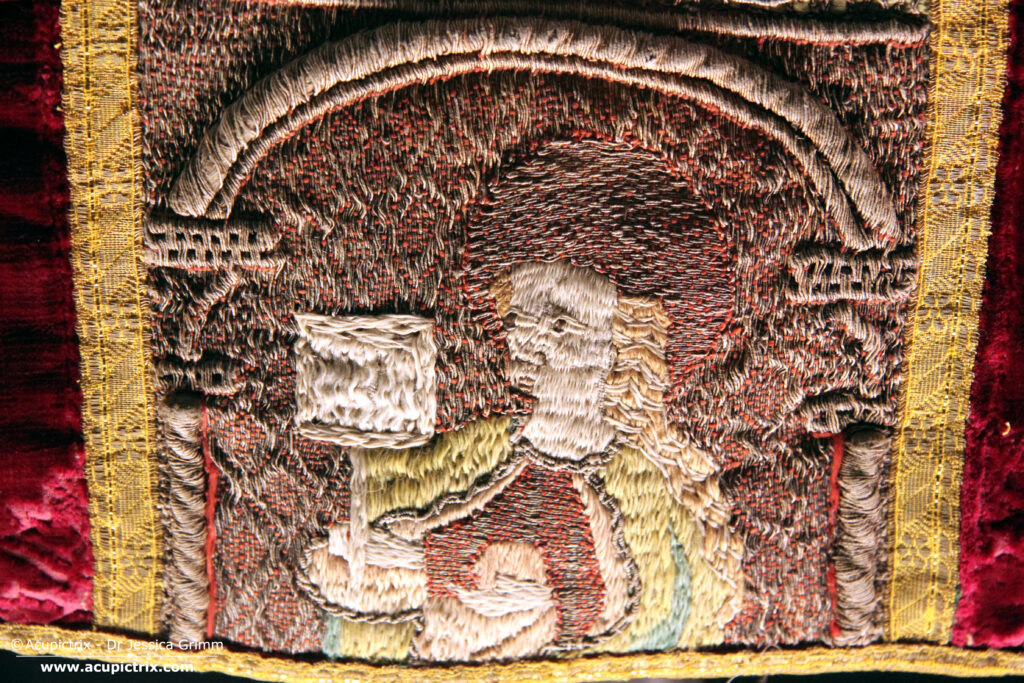Last week, we examined a medieval goldwork embroidery chasuble with two different types of stumpwork, dating to the first half of the 15th century and made in the Franconia region of Germany. This week, I have another lovely chasuble for you that also displays medieval goldwork embroidery from two older vestments. You can see the entry for this chasuble on BEWEB, the Italian website for historic and artistic heritage. Many medieval vestments in Italy are still owned and housed in their original parishes. The search function of the BEWEB database is an excellent resource for finding these pieces.


Above are pictures of the back and front of the chasuble from the Sant’Anna church in Sant’Anna d’Alfaedo in the diocese of Verona. The first church built in this mountain village was consecrated on May 27, AD 1425. As was the custom in this area, the wealthy families elected the parish priest and determined the duration of his tenure and the salary he would receive. It is likely that the priest owned his chasuble and brought it with him when he took up the job at Sant’Anna.
As you can see in the pictures above, the medieval goldwork embroidery on the back and the front of the chasuble differs. The embroidery on the back was made in the first decade of the 15th century in Southern Germany. The embroidery on the front was made in the third quarter of the 15th century, probably in the Franconia region of Germany. Matching these dates to the parish records means we can guesstimate which priest brought which part of the current chasuble to Sant’Anna. The first priest, Giovanni Uberti, was in office from AD 1404 and can be linked to the medieval goldwork embroidery on the back. The front can be linked to Thomas de Alemania (Thomas the German) or his successor Marino Tedesco (Marino the German). No wonder these German men wore embroidery from home.

Unfortunately, I could not photograph the front of the chasuble when it was exhibited at the Castello del Buonconsiglio in 2019. From the top, the medieval goldwork embroidery shows Saint Peter with his key flanked by two large flowers, Saint John with a chalice and a snake, and Saint Bartholomew with his knife. The embroidery is executed on 28 ct evenweave linen. The metal thread used is membrane gold and silver. This is typical of medieval goldwork embroidery from Germany.
Last week’s medieval goldwork embroidery could be classified as stumpwork embroidery. The above embroidery also uses a moderate amount of padding. Folds in the saints’ undergarments are padded with string and then covered with horizontal pairs of metal thread. String padding is also used for the arches and the basket weave bands between the orphreys. The basket weave bands show these typical alternating triangles of coloured silk and metal thread. You can find a tutorial on this technique here.
The golden background behind the saints consists of a lovely diaper pattern in red silk. It is a large basket weave with a central ‘window’. Although the embroidery looks less sophisticated than last week’s, it isn’t too simplistic once you look more closely. The blue vaults above Saint John and Saint Bartholomew are embellished with small golden spangles. Saint John’s long flowing hair consists of over-twisted natural silk. And the seams of the outer garments and the edges of the halos are embellished with a gimp made of membrane thread wrapped around a silk core.

The medieval goldwork embroidery on the back of the chasuble from Sant’Anna was likely made just a little further south than that on the front. It uses the same materials: coloured silks and membrane thread. From the top, we see Saint Catherine with a sword and a broken wheel, the Madonna with child, Saint Barbara with a chalice, a communion wafer and her tower, followed by Saint Margaret with her dragon and a female saint that cannot be identified at the bottom. This iconography is known as the Virgo inter Virgines.
What I like most about this chasuble is that the medieval goldwork embroidery was deemed precious enough to be removed from the original German vestments and re-made into a new, shortened Italian velvet chasuble. The embroidery was always part of the treasury of this parish church in an ordinary mountain village near Verona in Italy.
Literature
Prá, L. Dal, Carmignani, M., Peri, P. (Eds.), 2019. Fili d’oro e dipinti di seta: Velluti e ricami tra Gotico e Rinascimento. Castello del Buonconsiglio, Trento.
